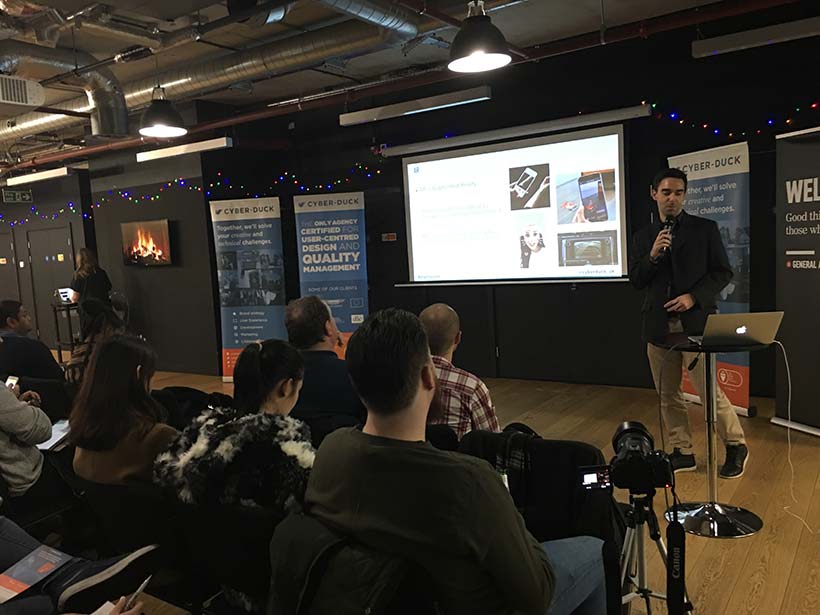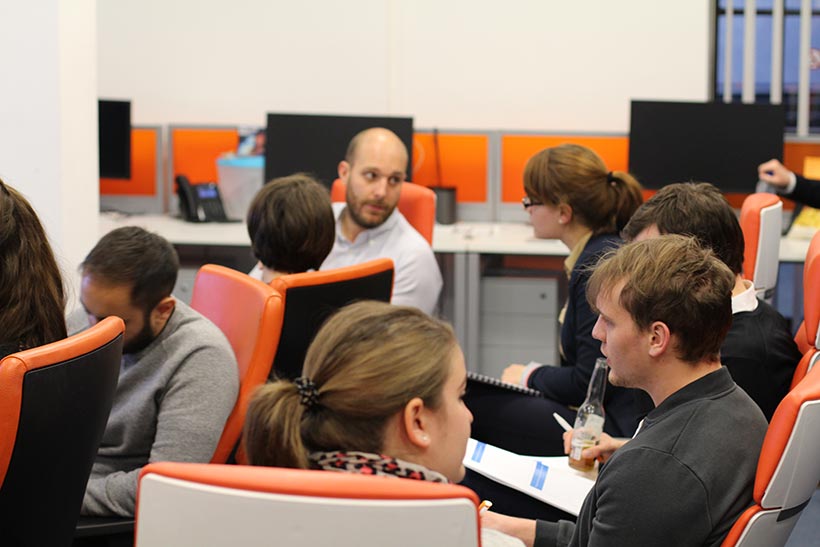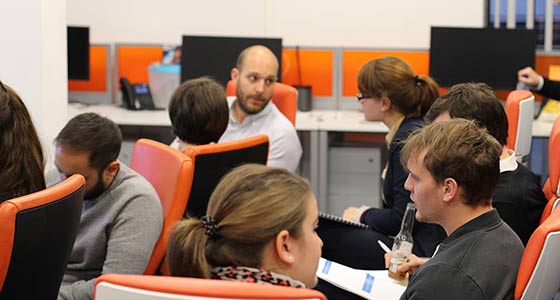With the financial year ending soon, you need to start thinking about what the new year holds. After close analysis of the market, we’ve identified the greatest areas your business needs to incorporate to make a success of the 2019/20 year!
At Cyber-Duck, we pride ourselves on our expertise. We keep tabs on all the latest changes in the digital industry: whether it’s the technology or the research and design process, if there are new thoughts out there we’ll be among the first to know it. For instance, recently our tech chiefs Gareth and Clem were at the Great Container Management Debate (click 'More Details' on the right for more info), learning about the future of container management in application hosting/services. (For those of you who don’t know, a container is a piece of software that includes everything needed to run it, isolating it from its surroundings to make it easier to develop and stage digital environments – interesting stuff!)
But with so much information out there, it can be hard to settle on the most pertinent areas for your business. This year, we’re taking a different approach to cross-sector trends and industry moves – our focus is on tech and the user. First up, we’ll talk about the technology trends we think are the ones to watch this year.
Tech Trends

We always have our ears to the ground over all things tech and user related. Here Sylvain delivers insights about Virtual Reality at the Digital Pond in December, 2017.
Conversational UI
To begin, let’s look at the rise of conversational user interfaces (UI). These UIs allow users to search or browse the web using only their voice or a bot. They are everywhere nowadays – if you haven’t heard of Siri, Alexa, or Google Home, you must have been living under a rock. Last year, an estimated 50 million Google Homes and Amazon Echo were going to ship throughout 2017. The actual sales probably dwarfed that.
Meanwhile, conservative estimates suggest that 30% of our interactions with smart devices will be through “conversations” by 2019. It’s safe to say that the technology is coming and it’s coming fast – especially when you consider how quickly Artificial Intelligence is evolving. The challenge for us is to find ways to ensure the UX is concise and enjoyable, providing users with meaningful interactions they both need and want.
But we shouldn’t just limit our thinking to chatbots and personal assistants when we think of a UI. In fact, we could take things a lot further. Take Fitbits and Apple Watches: these wearable technologies bridge the gap between the physical and the digital. In the coming years, how can we explore different user experiences using this tech as a starting point?
Look out for:
- Voice assistants
- Artificial Intelligence
- Wearables
- Content as bots
OPEN BANKING
If you haven’t heard, there’s a new form of banking in town: it’s called open banking. This is the democratisation of banking that puts the power back in the hands of the saver. It’s about control and about finding the deals that are right for you.
If you haven’t already, we recommend downloading your bank’s mobile app – that’s the first step, really. Through APIs, your financial information is pulled and shared with financial institutions in a secure, anonymised fashion. They can then recommend the best deals for you. Budgeting your finances is easier with real-time transfers and much more.
In our view, blockchain and cryptocurrency are part of this open banking revolution. We’ll be discussing blockchain in depth over the coming weeks. What you can take from us now is that blockchain can help to facilitate smart contracts and resilient identity verification.
Look out for:
- Blockchain
- Smart contracts
- Identity verification
- API-driven banking
Data & Security
Security should always have been at the top of your list anyway, but there’s never been a better time than now to prioritise data security. That’s because the General Data Protection Regulation (GDPR) comes into force this year, which will completely change how we handle personal data. You can find out more about the GDPR in our previous blogs – we even assessed its implications for user experience.
It isn’t just the GDPR that has us concerned with data security this year though. If you’ll remember, 2017 was a year highlighted by data breaches and hacking attempts. Most famously, the NHS was hit by a ransomware attack in May last year. Meanwhile, Yahoo admitted three billion customer accounts were hacked, but had kept this secret for three years. Businesses should educate and ensure their team understand and follow security principles in their personal lives; that will reinforce their professional ones.
We need to be better when it comes to data security. We need the investment, the expertise and the patience to create systems that are secure as possible from the outset. This year it’ll be more important than ever.
Look out for:
- GDPR
- Privacy by design
- Secure analytics
User Trends
As I said earlier, we’re very keen this year to tie tech to our users. Without understanding what it is that your users actually want, need to achieve and have used before, they will soon leave your tech behind for something that better suits their goals, desires and needs. So with that said, how can we appeal to our users in the coming financial year? The key user trends we identified are personalisation, diversity and diversity (see below).

At Cyber-Duck, we pride ourselves on our client workshops and extensive user research. Getting to grips with user needs is pivotal for us, so we were excited to outline user trends for the year.
Personalisation
The more control users have over their experience, the better. Likewise, if we can provide tailored experiences, ones that adapt to the needs and behaviours of users, we can make our products more personalised. What we’re talking about here are things like location-based settings which would automatically detect and change the language of a website; things like the ability to change the design and content of an app, personalising what features are prioritised based on what users prefer; and things like tailored hints and tips that help users to make the most of a product.
The trick is knowing what features and content users want, when they need it and why they need it. That means research, research and more research – you need to work with your users to find out what features are best. Data-driven design and a combined CMS/CRM driven approach will be pivotal in this.
Look out for:
- Data-driven and user-centred design
- Combined CMS/CRM
- Product analysis
Diversity
Our world is a diverse one – it’s time we started treating it like one. With 10% of the population dyslexic, 44% of pensioners disabled, and more than a third of Londoners foreign born (to bandy around just a handful of stats), it makes perfect sense to create your products with diversity in mind. While a niche subject may require niche designs, that doesn’t mean you can’t make your product as diverse and accessible as possible.
It is about being inclusive and therefore widening your potential audience as much as possible. Just as a diverse economy is a strong economy because it has multiple sources of revenue, so too will a diverse product succeed because it has multiple user bases. Thinking diversely can also help you to identify fresh market openings, or allow you to tailor products to that market’s needs. For instance, the Indian market mostly uses Android, and the African market is growing at a faster pace than most, a fact that has not been ignored by Facebook. Noticing these moves and building products to capitalise on them is what diversity is all about.
There’s one last area to think about too though: when it comes to inclusivity regarding age, it isn’t just about the current older generation. As our UX designer Paul outlined in his age-inclusive design blog, accessibility isn’t designing for another group of people you’ll never interact with – one day you’ll be old too, and you’ll need an accessible product!
Look out for:
- Accessibility
- Inclusive Design
- API-driven design
Storytelling
You could have the most impressive tech on Earth, but if you haven’t got a good story to underpin it, what’s the point? No one will know about it, nor will anyone want to keep using it even if they did. That’s why in 2018 we’ll be looking at storytelling. We’re going to see a move towards more meaningful content and products, as well as more sensible, thoughtful marketing campaigns. After all, nobody wants to see another Pepsi or Dove mishap.
Currently, we are bombarded with marketing material. This article is a case in point – from a quick search, I found three million results for ‘digital trends 2018’. Most, undoubtedly, will be full of fluff and not useful to anyone. Some will impart meaningful knowledge, but not nearly enough.
The onus is on content creators and product designers to generate meaningful interactions, especially with the decline of organic traffic on Google and Facebook. What we need to do is to create effective brands and marketing strategies that people can enjoy.
Look out for:
- Brand strategy
- Content strategy
- Marketing strategy
Let's Work Together
There's clearly a lot out there you should incorporate into your business models to make a success of the future. But with Cyber-Duck to hand, you don't need to worry. At our regular meet-ups, the Digital Pond, we address the hottest digital topics of the moment: from GDPR to Empathy in Design and much more besides, it's a great opportunity to learn and network with like-minded people. Be sure to join us!
But if you're unsure how the latest trends can be applied to your business, we can help there too. We offer comprehensive UX, data and marketing audits to businesses. Through these, we can identify where your customer experience can be improved, or how you can ensure your business is GDPR compliant. Contact us today for more information.

